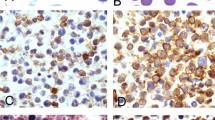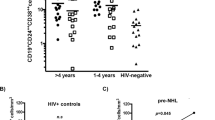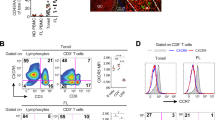Abstract
Fas ligand (FasL) is capable of inducing apoptosis of lymphoid cells by cross-linking with its natural receptor, Fas. We aimed to investigate the possible role of the Fas/FasL-mediated apoptosis in the development of human lymphomas. FasL mRNA was detected by reverse transcriptase-polymerase chain reaction in 38 out of 63 lymphoma biopsy specimens representative of various subtypes of non-Hodgkin’s lymphoma (NHL) and Hodgkin’s disease. FasL was co-expressed with Fas mRNA in most cases. Flow cytometry (FACS) analysis showed a bright FasL staining in 31% to up to 75% of the total cell population from 14 out of 16 samples; the presence of the FasL protein was confirmed by Western blotting. Dual-color FACS analysis showed that FasL was expressed by T cells in B-NHLs and T-NHLs. A significant percentage of B cells in various B-NHLs also stained positively for FasL. Freshly separated neoplastic B cells from three FasL+ and one FasL− B-NHLs displayed a relative resistance to Fas-mediated apoptosis, when compared to reactive T cells isolated from the same tissue samples. In contrast, the sensitivity to Fas-mediated killing of the T cells isolated from two FasL+ T-NHLs was not uniform. These data show that (1) FasL is expressed in both neoplastic and reactive cells from a significant proportion of lymphoma cases, and (2) that the intratumoral FasL+/Fas+ reactive T cells are more sensitive to Fas-induced apoptosis than the neoplastic FasL+/Fas+ malignant B cells. A putative defect in the Fas/FasL pathway may thus favor the development of malignant B cell populations.
This is a preview of subscription content, access via your institution
Access options
Subscribe to this journal
Receive 12 print issues and online access
$259.00 per year
only $21.58 per issue
Buy this article
- Purchase on Springer Link
- Instant access to full article PDF
Prices may be subject to local taxes which are calculated during checkout
Similar content being viewed by others
Author information
Authors and Affiliations
Rights and permissions
About this article
Cite this article
Xerri, L., Devilard, E., Hassoun, J. et al. Malignant and reactive cells from human lymphomas frequently express Fas ligand but display a different sensitivity to Fas-mediated apoptosis. Leukemia 11, 1868–1877 (1997). https://doi.org/10.1038/sj.leu.2400815
Received:
Accepted:
Issue Date:
DOI: https://doi.org/10.1038/sj.leu.2400815
Keywords
This article is cited by
-
Histone deacetylase inhibitors potentiate TNF-related apoptosis-inducing ligand (TRAIL)-induced apoptosis in lymphoid malignancies
Cell Death & Differentiation (2004)
-
Mechanisms of resistance to TRAIL-induced apoptosis in primary B cell chronic lymphocytic leukaemia
Oncogene (2002)
-
The kiss of death: promises and failures of death receptors and ligands in cancer therapy
Leukemia (2001)
-
Direct in vivo transfection of antisense Fas-ligand reduces tumor growth and invasion
Gene Therapy (2001)
-
Inducible resistance to Fas-mediated apoptosis in B cells
Cell Research (2000)



